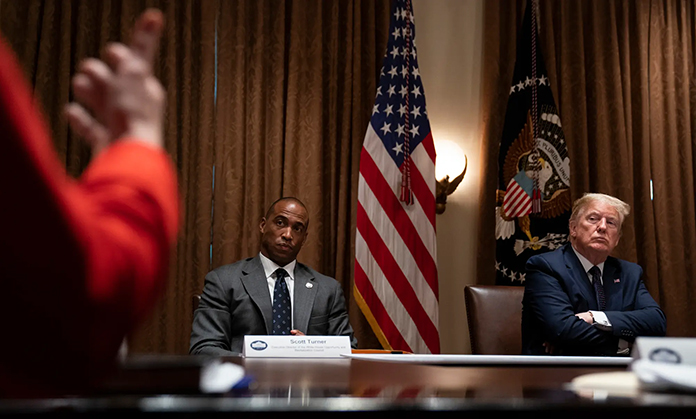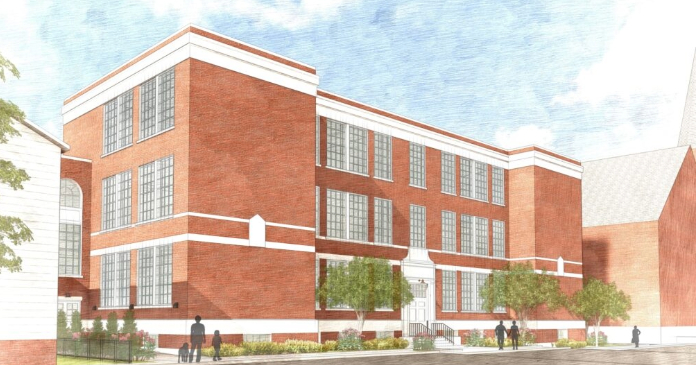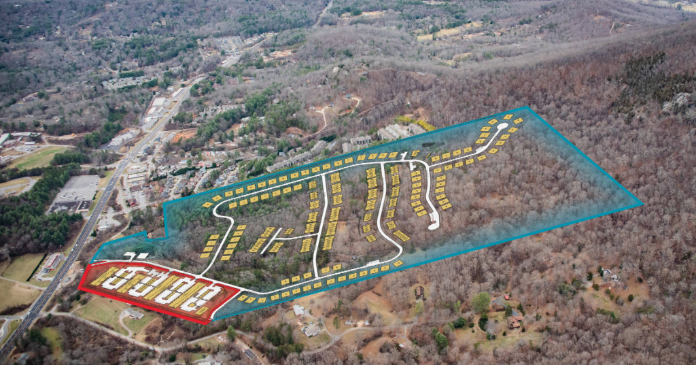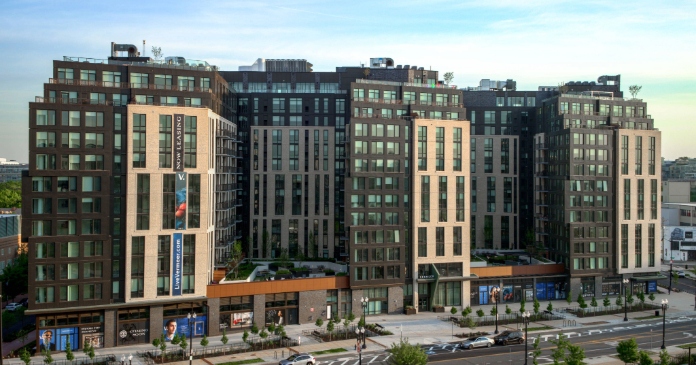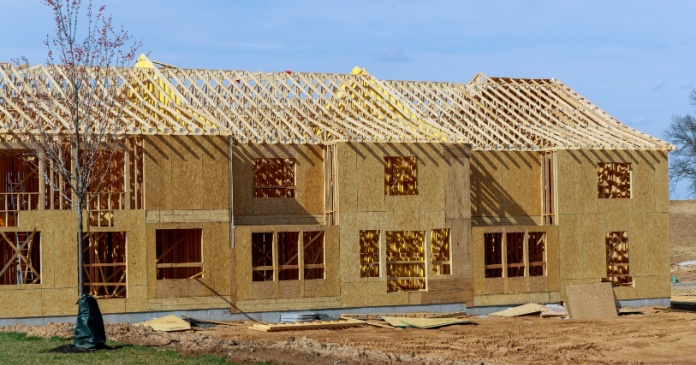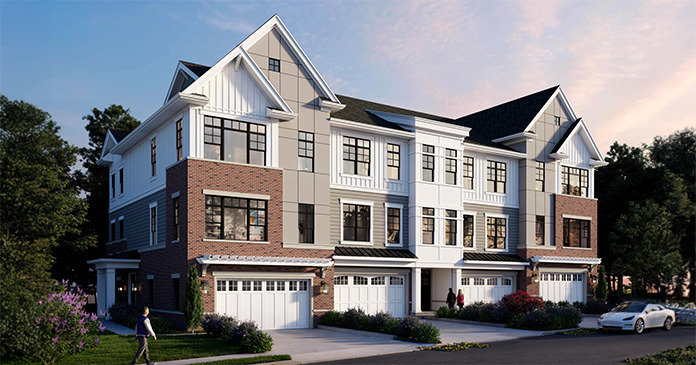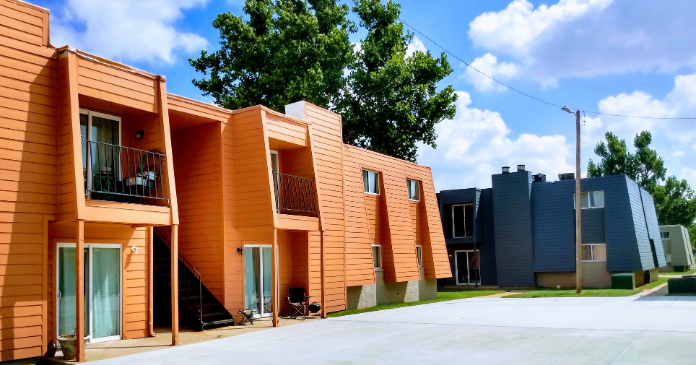The company’s execs caught market watchers by surprise this year with the announcement at the end of January that UDR has entered into a contract to sell 25,684 apartments spread from Oregon to Delaware in a deal that is expected to close in the first few days of March. The pending sale is intended to take advantage of the pricing disparity between public stock price and private asset values, create more financial flexibility for the REIT in a period when liquidity is increasingly difficult to come by, and focus the company for even more efficient execution of its strategies.
Thanks to that deal and the corporate reorganization that accompanies it, Toomey and his team have created a base upon which to build a company he believes now is perfectly positioned for growth. “It’s done,” Toomey said of the portfolio repositioning program he and Senior Executive VP Mark Wallis started when they took over UDR’s two top spots in early 2001.
“We have completed the right-sizing of this organization,” he told analysts during the REIT’s Q4 2007 earnings call on January 30, the day after the announcement that UDR entered into the contract to sell the portfolio consisting of 86 communities with an average age of 24 years, located in 11 states, to value-add specialists DRA Advisors and Steven D. Bell. Upon completion of the deal, UDR will own 40,183 apartments in 146 communities with an average age of 15 years in 20 markets spread over 10 states.
Since 2001, UDR has sold between $400 million and $700 million of assets every year in the portfolio overhaul effort. So, why change that familiar strategy now to sell in bulk? “We have dramatically accelerated UDR’s transformation with this portfolio sale,” said Toomey, explaining that the catalyst for the sale was the lull in the transaction market as many players scaled back their acquisition and disposition activity when the rosy year predicted for the multifamily industry failed to bloom. “In about April of 2007, we looked at what we could buy and didn’t really like the returns that we were seeing at those prices. So, if you don’t like the returns on acquisitions, that must mean it’s a good time to be a seller,” Toomey said.
Wallis agreed, explaining that one of the company’s major strategies always has been to strengthen the portfolio. “We’re always looking at how to do that and when the market is telling you it’s a good time to sell, the other question you ask is how long will it be a good time to sell, based on where you are at the time,” he said.
Toomey said, “We came to the conclusion that a properly structured transaction at this time would get it done and we were prepared, if the market wasn’t there for the right price, to just go back to our normal process of selling.”
But, he said, the market cooperated in terms of capital and debt available because there wasn’t a lot of product for sale at the time and at the same time UDR stock was trading at a two-year low, which provided the company the opportunity to take advantage of the disparity in value between private and public markets. “We sold a handpicked portfolio of assets that we would classify as below average compared to the remaining portfolio at a 6.5 percent cap rate, when the stock was trading in excess of a seven percent cap rate,” he said.
The average rent in Q4 across UDR’s portfolio was $984 per month, which will increase to an average of $1,200 when the 25,000 units that rent for an average of $744 per month are gone. Other benefits of the transaction include significantly lower capital expenditures for the rejuvenated portfolio and better exposure in locations demonstrating high rent growth, strong job growth and low single- family home affordability in the 20 markets where UDR will retain a presence. The ability to buy back shares on an accretive basis, reduce debt and increase financial flexibility are other significant benefits resulting from the deal.
The overhaul of the portfolio isn’t the only transformation that has been going on quietly behind the scenes. “We completed a top-down review of the organization, as well as a bottom-up and looked at it as if we were starting over,” Toomey said. The company’s leaders came to the conclusion that, first and foremost, they had to move the corporate office to Denver, which has been the base of operations for company executives since Toomey and Wallis came on board. Toomey took over UDR’s top spot in February 2001, when former CEO John McCann, who founded the company in Richmond, Va., with a group of Virginia businessmen in 1970 as Realty Industries, Inc., retired, and Wallis joined Toomey a month later, but the company’s titular corporate office has remained in Richmond until now.
“We needed to realign a lot of our resources around our key drivers and our business leaders,” Toomey said, explaining that around 60 of those individuals now work out of the company’s Dallas office, which represents the core of UDR’s development efforts, and 80 others are focused on redevelopment and some backroom support functions in the Richmond office. “And then you have Denver, with about 80 dealing with corporate, technology, human resources, finance and financial reporting,” he said, adding that the company took a $3.6 million charge in relation to the reorganization, but expects to save around $2 million annually thanks to those staffing changes.
“In essence, we transformed the company in one fell swoop,” said UDR’s CEO, who is no stranger to the transformation game. It was just about a year ago when Toomey and his team announced the extreme makeover of the company’s public image from that of a middle-market, renter-by-necessity-focused apartment company to their vision of the innovative real estate investment of choice in the industry. That remodel included changing the company’s name to UDR Inc. from its former somewhat clunky moniker United Dominion Realty Trust, reworking the logo in a new greenish hue and creating a new tag line –“Opening Doors to the Future.”
Also included in that stage of the company’s two-step metamorphosis were a completely revamped, consumer-focused website and the christening of the company’s taxable REIT subsidiary RE3, with plans to expand that agile entity to include all of the newly named company’s development, land entitlement and zoning changes and short- term-hold investment opportunities to take advantage of changing market conditions.
And, while announcements of last year’s re-branding and this year’s transformation took many industry watchers by surprise, neither was wrought overnight. The reshaping of UDR’s public image took a year to put together and about the same amount of time will have elapsed between the decision to sell the portfolio and closure of that transaction, which was kept well under wraps until the agreement was signed.
“We knew when we assembled the idea back in May and June that it was going to succeed under a couple of circumstances,” said Toomey, explaining that the deal depended on UDR’s ability to present financing in place and, because of the portfolio’s size, it would be necessary to limit the number of bidders. “It was just easier to go to the leaders of those organizations and contact them directly and that helped us keep the lid down,” Toomey said.
“We worked with consultants to identify who the most probable buyers were versus doing a wide casting of a net that who knows what you’d bring in,” Wallis said.
The arrangement of the financing that UDR’s leaders believed was key to getting the deal done within the uncertain window of opportunity the turbulent money market presented was initiated some five months before the agreement was inked. With Fannie Mae’s help, the company started underwriting each of the assets that had been carefully handpicked to leave UDR with the perfect portfolio.
UDR fronted the dollars to fund a physical survey of each asset and the title work, so the company could present the hand-picked auction group a pre-packaged loan with a Fannie Mae pricing grid. “In essence, that put them on equal footing because they knew where they could get their financing and, in today’s market, without the financing no deals are getting done,” Toomey said. “In the end, we had pricing power, we were running them against each other and we picked the group that we thought had the highest degree of certainty and the right price.”
It was Marty Cicco who helped UDR keep the deal quiet until the end of January and provided an efficient conduit of communication with the potential buyers. Cicco, who founded MJC Associates, a small boutique advisory firm, in 2006, after retiring from his position as vice chairman of Global Commercial Real Estate with Merrill Lynch, acted as financial advisor to UDR and ran the auction that resulted in the agreement with DRA and Steven D. Bell.
Cicco became officially involved in the deal’s organization in October and started the process of contacting the possible prospects shortly thereafter.
“We went to about a dozen to 15 players at various levels and if they weren’t interested, we knew pretty quickly,” he said. “Some were domestic, some were international, some were opportunity funds and some were operators. We didn’t go to any other public entities. They were all in the institutional money management world,” Cicco said of those he approached on UDR’s behalf.
“Some of them were people that had financing and needed to find an operator and others were operators that needed to find financing, but through that process we filtered it down to about eight and active due diligence with those eight led to four in the final weeks of the process,” Toomey explained. That final four included two foreign investors, one pension fund advisor and one leveraged buyer.
“Making sure we timed the process of lining up the financing commitment to when the bidders were prepared to actually move forward was the real key,” said Cicco. “In any process, you’re trying to keep a competitive dynamic as long as you can, and I think the foresight that was really helpful here was getting the financing process started on behalf of the company before we really knew who the buyer was going to be.
“UDR spent some capital to get that process started, and I think that was the critical part with respect to pushing the button in late November. The portfolio had been underwritten by Fannie and Red Capital, so they were able to actually issue a commitment while we still had a competitive process going forward with the equity players, in order to maximize the value and insure certainty,” Cicco explained.
There were some unsettling moments as the deal made its way to the agreement stage, he said, due to the turbulence in the lending sector through November, December and January. “And even as we sit here, the markets are very unsettled,” he said in February.
Despite the market turmoil, Toomey is confident that the transaction will close as expected, with UDR receiving $1.5 billion in cash and a $200 million note receivable with a fixed rate of 7.5 percent with a maturity of six years, locked out for pre-payment for 14 months, by which time he expects it will be paid.
The deal will result in UDR’s exit from Arkansas, Delaware, North and South Carolina and Ohio, leaving the company with a portfolio that is 90 percent located on the West Coast, in the Washington, D.C.corridor and Florida. Upon completion of the sale, 47 percent of UDR’s NOI will come from West Coast assets, 24 percent from the Virginia-Washington, D.C. area and 19 percent from Florida.
Last year, UDR exited Atlanta and left North Carolina’s Triad in the summer of 2006 with the sale of a nine-property, 2,753-unit portfolio to Steven D. Bell, which has been on a buying spree for the past couple of years, ending 2007 with 14 real estate transactions in the final 50 days, including nine acquisitions and five sales totaling around $408 million. Those transactions brought Bell’s total acquisitions for 2007 to $730 million. Combined with the $677 million in dispositions, those deals resulted in the largest collective transaction year in the company’s 31-year history.
When the deal with UDR is done, the Bell firm will have ownership/ management interests in approximately 60,000 apartments, almost double the 34,000 units the firm owned and managed at the close of last year. As operating partner in the JV with DRA Advisors, Bell will handle on-site management at all the newly acquired properties, adding around 600 new employees to the company that also invests in senior living and retail assets.
“This portfolio offers an outstanding diversified investment opportunity for our Bell Fund II investors, our other accredited high- net-worth investors and our institutional partner, DRA Advisors,” Jon Bell commented, when the deal was announced. “A by-product of the transaction is that our company will become one of the 15 largest managers of apartment properties in the U.S,” he said. Over the past four or five years, Bell and DRA have teamed up to purchase some 7,000 apartments.
Bell President Ed Harrington was attracted by the geographic diversity of the portfolio, which includes 7,598 units in North Carolina, 512 in Arkansas, 1,752 in South Carolina, 7,537 in Texas and 569 units in Virginia, giving the company substantially increased economies of scale in those markets, where Bell already has a presence. Also, UDR and Bell use the same operating platform from both a process and a technology standpoint, which will make it easier to absorb the 600 new employees that will join the Bell organization as a result of the transaction. As many as 20 new employees could be added to the company’s corporate headquarters.
Following the close of the deal, multifamily will make up around 60 percent of Bell’s holdings with senior living facilities and retail making up the other 40 percent. “This year, we’re going to focus on multifamily and senior living. Retail’s not on the top of our list because of the economy and talk of recession,” explained Harrington, who expects the partners will spend between $65 million and $75 million on renovations at the 86 communities over the next three to five years.
“We’ll probably do 10 to 12 at a time, picking the assets where we’ll get the most value. And as we complete those, we’ll pick some more,” he said of the rehab process that is a Bell specialty. In addition to the standard attention to deferred maintenance issues involving asphalt and exterior paint, Harrington expects Bell’s rehab team will go in and redo kitchen counters, cabinets and lighting, replace flooring if necessary, do some bathroom makeovers and add ceiling fans and other finishes that will justify rent hikes at the assets the partnership probably will hold for three to five years. UDR already had performed kitchen and bath makeovers on about 20 percent of the units.
And, while UDR has been shopping for 1031 deals to soak up some of the proceeds and absorb some of the $840 million tax gain from the sale, targeting between $500 million and $600 million in deals, of which $320 million was already under contract, Harrington doesn’t expect much more apartment acquisition activity for the Bell firm in the immediate future.
“It’ll be a while before we buy more multifamily. Not that we don’t want to, but it’ll take us around 60 to 90 days to absorb these 25,000 units,” Harrington predicted.
Nor does he have any new multifamily markets on his radar screen.
Currently, Bell has apartments in about a dozen markets, primarily in the Southeast, and the portfolio purchase gives the company a presence in six new markets–Delaware, Ohio, Maryland, Florida, Oregon and Washington. Harrington would like to expand the company’s footprint on the West Coast over the next three to five years, if the market allows.
He expects Fund II’s $125 million war chest will be fully invested over the next six months, with acquisitions of some senior living communities, a few more good solid Class B apartment properties in good locations where rehab can add value and a little bit of retail, with that sector representing probably less than 10 percent of the fund’s investment.
The Bell firm expects to launch another opportunity fund in the $100 million range by the end of this year. However, Harrington said, the company is optimistic but cautious about multifamily right now because of the number of unsold single-family homes on the market and the uncertainty about how that shadow supply of competing product will affect the ability to raise rents. “I don’t think we’re going to be able to raise rents like we did in 2006 and 2007. If we raise rents three percent to four percent this year, we’ll be fortunate,” Harrington predicted.
DRA’s pre-closing portfolio of multifamily assets totals nearly 20,000 units in a dozen mostly Southeastern and Midwestern states and Texas. Acquisition of the UDR portfolio will add eight new markets– Arkansas, Delaware, Florida, Maryland, Ohio, Oregon, Virginia and Washington–to the company’s nationwide multifamily portfolio that will stretch from coast to coast when the deal is done.
The investment advisor that specializes in real estate investment and management services for institutional and private investors currently has $9 billion in assets under management. DRA conducts its investment activities through a series of commingled funds, primarily the DRA Growth and Income Funds, for which the clients are public and private pension funds, university endowments, foundations, financial institutions and high-net-worth individuals. The 20-year-old company’s first opportunity fund was created in 1995, followed by formation of DRA Growth & Income Funds I through VI, all of which are designed to be diversified across the major property types and locations to limit risk. The most recently created fund will be used, in part, to finance the acquisition of the UDR portfolio.
The firm’s $9 billion of assets also include more than 20 million square feet of office and industrial space and 32 million square feet of retail space.
“Multifamily is currently approximately 17 percent of our portfolio and the UDR deal will increase that to over 25 percent,” said DRA Director of Acquisitions Adam Breen. DRA will consider opportunities in its new markets on a case-by-case basis, as has been its strategy for the past 20 years, during which the company has acquired more than 700 office, retail, industrial and multifamily assets valued at more than $15 billion.
Breen said DRA learned about the opportunity to purchase UDR’s portfolio in October and started to seriously underwrite the transaction in November. “We were attracted to the portfolio because it is well diversified, well managed and well maintained. The portfolio also has strong going-in cash yields and achievable upside through targeted capital investment.”
While UDR may be transformed by the deal that will slim down its holdings by about one third, the transformation is far from over.
Having created a solid foundation on which to build a better, stronger, more lucrative UDR, Toomey expects the company’s development and redevelopment plans will have a greater impact on a smaller enterprise. “We’ll hold onto these 40,000 apartments to start with and we’re eager to grow,” said Toomey. “We’ve got a development pipeline right now with 6,000 apartment homes under construction and another 4,000 that are under redevelopment, so we’re going to grow the asset in home counts, but it’s going to be in the right markets at the right times,” he said.
UDR has earmarked $2.6 billion for development to be portioned out at the rate of $400 million to $500 million annually with target returns of 6.5 to seven percent. Of the $400 million expected to come on line this year, 80 percent is in Southern California, Texas and the D.C. corridor. Looking out to 2009, some 80 percent of the ground-up projects will deliver in Texas, Southern California and Seattle.
Florida, Virginia, Tennessee, Maryland and Texas are the focus of UDR’s redevelopment efforts this year. The rejuvenation of six communities totaling 1,900 units is underway with targeted returns of eight to 10 percent on the $86 million incremental investment. The company expects post-renovation cash flows from those communities to increase 50 percent to $16.7 million. West Coast assets will be added to the redevelopment pipeline in 2008 and should start delivering this year and into 2009.
The perfection of the new UDR depends heavily on its enhanced ability to respond quickly and appropriately to ever-changing market conditions, which the company believes is the only way to guarantee value creation over time. “I think we have the right platform and the right people to do it,” Toomey said.






